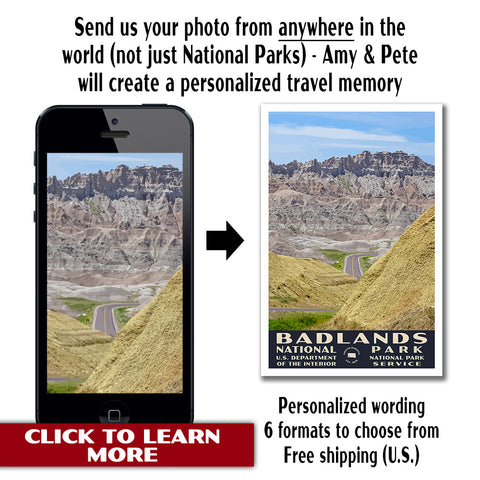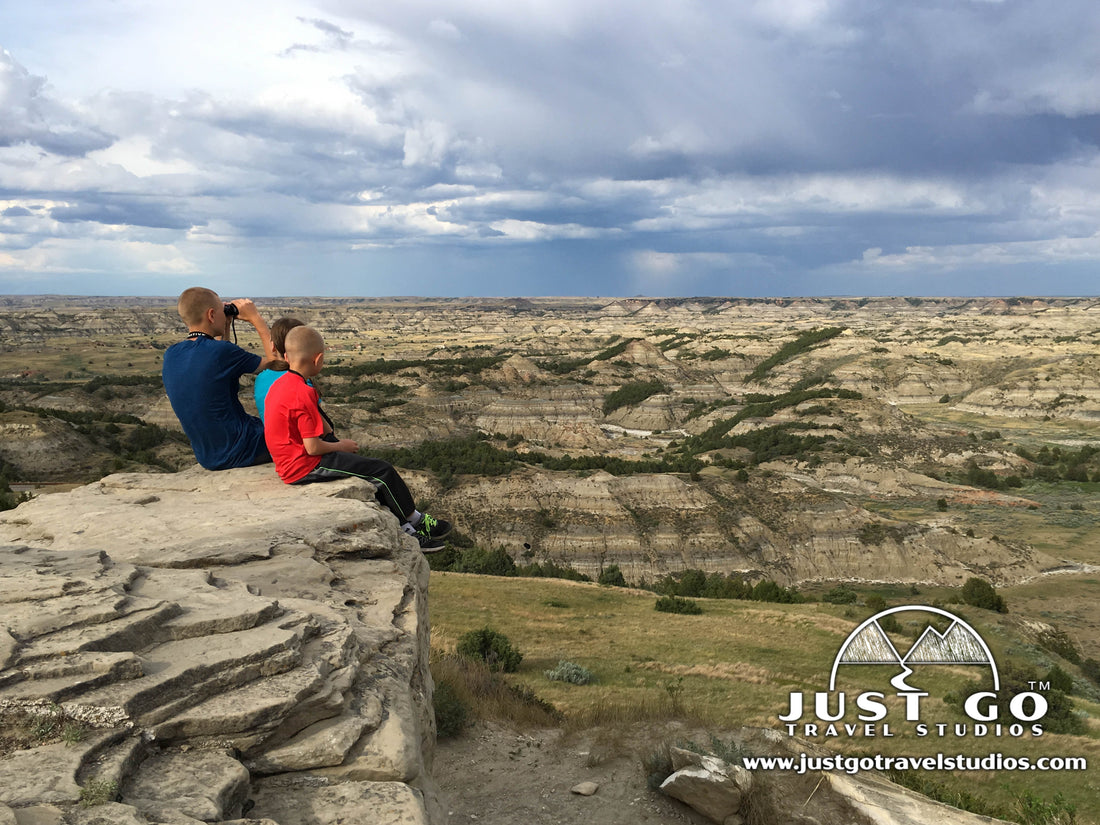Theodore Roosevelt National Park stretches alongside the banks of the Little Missouri River in the rugged Badlands of western North Dakota. Visitors to this park are provided a unique opportunity for wildlife viewing, solitude and sweeping views. North Dakota may not be on your travel bucket list, but it should be!

Over 700,000 people visit Theodore Roosevelt National Park each year. However, many of these only ever made a pit stop at the Painted Canyon Visitor Center while passing through on I-94. Painted Canyon is a beautiful stopping point, but it is only small sample of what makes this park special. You’ll need far more time to fully appreciate the beauty, the wildlife, and the history behind Theodore Roosevelt National Park.
Although the park is open year-round, the busiest months are June, July, and August. We visited late June, after spending several days in Grand Teton and Yellowstone National Parks. After leaving behind the crowds of summer tourists in Yellowstone, we were thrilled at the peace and tranquility we discovered in this often-overlooked park. We highly recommend you take at least a day to explore Theodore Roosevelt National Park and make sure to get out of the car and spend some of that time on foot!
These are some reasons why we think you’ll fall for Theodore Roosevelt National Park, too!
Theodore Roosevelt National Park hikes and sights are highlighted in our 10+ page itinerary for Badlands National Park, Wind Cave National Park and Theodore Roosevelt National Park Itinerary.
1) SCENIC DRIVES IN THEODORE ROOSEVELT NATIONAL PARK
There are three park units—the popular South Unit, the more remote North Unit and the Elkhorn Ranch Unit. Each of the two main units (North and South) has its own scenic drive. The Scenic Loop Drive in the South Unit is one of the best ways to explore the park if you are short on time and only have a few hours to explore. This 36-mile winding loop road leads to various hiking trails and scenic overlooks. Though it wouldn’t seem that you’d need much time to drive 36-miles, the opportunities for hiking, photographs and wildlife viewing are plentiful, so we recommend at least two hours, even if you don’t plan on hiking.


If you are able, we highly recommend driving the loop in the evening. As the sun is setting, you’ll be rewarded with stunning skies, animal sightings and a lack of traffic. If you are visiting for a few days, drive the loop more than once. We drove the full loop twice and could easily have gone back again given more time. Trust us, watching wild horses and prairie dogs is addicting!

68 miles away from the South Unit and just off US 85, you’ll find the North Unit. Although this section is about half the size of the South Unit and fairly remote, it is worth your while to drive the hour north to take in the dramatic North Unit views AND to access a couple of our favorite hiking trails in the park (you’ll have to read on for those trails)! From the entrance station, the 14-mile Scenic Drive meanders through the North Unit.


Be sure to stop to check out the Cannonball Concretions, take a short walk to the stunning River Bend Overlook and drive to the end of the road at Oxbow Overlook where the Little Missouri takes a hard turn to the east. There isn’t as much wildlife here; so, if you have only one day to visit both units, visit the North Unit in the morning/early afternoon and return to the South Unit in the evening for sunset and wildlife viewing.
2) WILDLIFE VIEWING
If you love watching and photographing wildlife, then look no further! The South Unit offers many opportunities for viewing a variety of wildlife including black-tailed prairie dogs, badger, bison, elk, pronghorn, and feral horses.



The South Unit Scenic Drive passes right through three prairie dog towns, where the little rodents are thoroughly entertaining to watch. We were surprised to see some exit holes for the prairie dogs’ extensive underground tunnels right in the middle of the paved road! There are also a few prairie dog towns in the North Unit, but they aren’t visible from the road and you’d have to hike to see them.



The popular feral horses are easy to spot in the South Unit. Feral horses, commonly referred to as wild, are unowned, untamed bands of horses descended from domesticated animals that once lived on the Great Plains. They typically range in small bands of 5-15 and can be seen grazing throughout the park in the summer months. The Boicourt Overlook Trail on the northeast side of the Scenic Loop Drive is a popular place from which to spot them. If you don’t see any here, they likely aren’t far away. Keep in mind, these horses are wild and shouldn’t be approached.



3) THEODORE ROOSEVELT HISTORY
Theodore Roosevelt National Park is the ONLY national park named after a person and pays tribute to our 26th president who was known as the “Conservation President.” Theodore Roosevelt first came to these very Badlands to hunt bison and invest in a local cattle operation known as the Maltese Cross Ranch. A year later, he returned in search of solitude and healing after the deaths of both his wife and his mother and built Elkhorn Ranch. His time spent in the Dakota territory helped shape his views on conservation. As president, he established the US Forest Service, numerous national forests, monuments, federal preserves and 5 national parks. Theodore Roosevelt National Park wasn’t established as a national park until 1947, after his death; however, you could say that his time spent in the Badlands forever altered our nation, and he left behind a legacy of conservation.

At the South Unit Visitor Center, you’ll find a museum with natural history displays and some of Theodore Roosevelt’s personal items. Behind the visitor center, you can visit Roosevelt’s Maltese Cross Cabin, which was moved from its original location and restored. Just make sure you read the story about the rocking chair--it is our favorite!

4) HIKING TRAILS
Hiking and exploring in Theodore Roosevelt National Park was so much more than we thought it would be! Every single trail we explored led to an amazing view. Trails range from easy, paved nature walks to challenging backcountry hikes. Here are some of our favorites in order of difficulty.
Buck Hill (0.2 mi RT; South Unit): This short but steep paved trail on the eastern side of the scenic loop drive leads to the highest accessible point in the park (the actual highest point is Peck Hill visible to the southwest). Once at the top, you are treated to 360-degree views of the badlands. It can be pretty windy up here, but the views are amazing! Plus, it’s a great spot to bring a pair of binoculars and scan the valleys for herds of horses moving through the park.


Wind Canyon (0.4 mi RT; South Unit): This nature trail on the northwest corner of the scenic loop is a must-do! It leads to a cliff edge overlooking the Little Missouri River. We returned twice to this beautiful trail since the light here changes throughout the day. In our opinion, it is the best place to watch sunset! (Just be careful near the cliff edges.)



Ridgeline Trail (0.6 mi RT; South Unit) Explore the badlands on this scenic nature trail. This trail has some rolling terrain and steep stairs but is short in distance.

Caprock-Coulee Nature Trail (1.4 mi RT; North Unit): On this walk through badlands terrain and dry washes, you can learn about the plants and geology of Theodore Roosevelt National Park. A trail brochure is available at the trailhead.


Sperati Point via the Achenbach Trail (1.5 mi RT: North Unit): This trail which begins at Oxbow Overlook, starts out as an easy walk through the prairie but leads to a small rise in the landscape before ending at Sperati Point. Enjoy views of the Little Missouri River at Sperati Point. When other trails might be wet and muddy, this is a good hiking option. However, be warned that there is a decent amount of poison ivy on this trail!


Caprock-Coulee Trail (4.3 mi loop; North Unit): If you are looking for something more adventurous and strenuous, we think this loop trail is the most beautiful one in the park! A ranger highly recommended this hike, and we’re so glad we followed his advice! The first .75-miles of this trail is the Caprock-Coulee Nature Trail. If you decide to continue past that point, make sure to bring lots of water and wear sunblock. It can get quite hot in the summertime, and there is little to no shade for most of the hike.


After leaving the nature trail, it becomes more strenuous as the trail climbs to the top of a grassy butte. The trail follows a ridgeline with outstanding views. If you want to learn more about our favorite Theodore Roosevelt National Park hike, check out our blog about Hiking the Caprock-Coulee Trail!



OFF THE BEATEN PATH HIKING IN THEODORE ROOSEVELT NATIONAL PARK
If you are looking to get off the beaten path, Theodore Roosevelt has many backcountry trails not shown on the park brochure maps. For more information on hiking off developed trails, be sure to use a topographic map and compass since the trails are minimally marked. Ask at one of the visitor centers for more information. Hikers and horseback riders who would like to spend the night in the park's backcountry can do so by filling out a free Backcountry Permit in the North or South Unit visitor centers. There are no developed backcountry campsites or facilities.

This Custom, Vintage-Style Poster was made by Just Go Travel Studios from a photo taken at the park by a client. To learn about our process or see a gallery of other vintage-style posters, click on the links for more information.
5) MEDORA
While it is not exactly inside the park, the town of Medora is certainly part of the Theodore Roosevelt National Park experience. This adorable town is situated at the entrance to the South Unit of the park. Almost every building in the town appears to be straight out of the wild west! Medora offers an assortment of restaurants, shops and lodging.

We were partial to our couple of trips to Hidden Springs Java. We even left town later than originally planned so that we could make sure we were able to stop here and get our coffee after they opened. Their staff was really friendly and helpful, and the cold brew coffee is especially worth checking out. Our kids loved their selection of backed goods as well. Make sure you stop here during your visit!

Our kids were partial to Cowboy Lyle’s Candy shop and the Barrels of Yum we purchased and enjoyed during the rest of our road trip. We didn’t have a chance to see the Medora Musical, but we hear it is the best show in the west!
We didn’t know much about the park before our visit and arrived with minimal expectations. However, Theodore Roosevelt National Park blew us away with its beauty and wildlife and has rightly earned its place on our list of favorite national parks. Whatever you do, make sure to add North Dakota to your travel bucket list because you are sure to fall in love with Theodore Roosevelt National Park, too!

WHAT YOU SHOULD KNOW BEFORE YOU GO TO THEODORE ROOSEVELT NATIONAL PARK
- Theodore Roosevelt fits nicely into other national park road trips. It’s five hours north of the Black Hills of South Dakota and can be combined with stops in Badlands and Wind Cave National Parks, as well as Mount Rushmore and beautiful Custer State Park! If you live east of the park, it is a great stop on a road trip to the west including Glacier, Yellowstone, and Grand Teton National Parks.
- The park is open year-round, 24 hours a day. Visitor center hours vary depending upon time of year. Note that the park is in two different time zones—the South Unit operates on Mountain time, while the North Unit operates on Central time.
- If you visit the park outside of peak season (May-September), expect for lots of closures in nearby towns. Medora is largely seasonal.
- Restroom facilities in the park can be found at the visitor centers and the campgrounds. If you are planning to do the scenic drive in the North Unit, be sure to use the facilities in the Juniper Campground and Picnic Area. The South Unit has a pit toilet about midway around the scenic loop drive, near the road to Buck Hill.
- There are no food services inside the park. Be sure to pack food and plenty of water. Water bottles can be filled at the stations in the visitor centers. Stay hydrated since temperatures can climb during the summer.
- All animals in the park are wild and should be viewed from a safe distance. Feeding animals of any kind is prohibited.
- Rattlesnakes are present in the park, so be alert while walking. We never saw any, but many trailhead signs warn of the possibility of encountering them.
- Be aware that poison ivy grows in some areas of the park. We noticed more in the North Unit while hiking.
ACCOMMODATIONS IN/NEAR THEODORE ROOSEVELT NATIONAL PARK
Lodging is not available inside the park but can be found in nearby communities of Medora (South Unit) and Watford City (North Unit). We splurged a bit and stayed at the Rough Riders Hotel in Medora during our visit to Theodore Roosevelt. This historic hotel was named for the volunteer cavalry unit led by Theodore Roosevelt. The walls in the lobby house one of the largest private libraries of books about or written by Theodore Roosevelt!
If you are planning to camp inside the park, there are two main campgrounds open year-round. Cottonwood Campground can be found in the South Unit just before the scenic loop drive. It is the only campground that accepts reservations. It is a primitive campground but running water is available in the summer. This beautiful campground is located along the Little Missouri River, and campsites are tucked in a grove of cottonwood trees. Even during the summer months, campers can find shade and relief from the heat here!
Juniper Campground, in the North Unit, is located five miles into the scenic drive and is first-come, first-serve only. This campground is far less crowded than Cottonwood and rarely fills. If you prefer the quiet and don’t mind bison grazing nearby, Juniper is the place for you!

FURTHER THEODORE ROOSEVELT NATIONAL PARK INFORMATION FROM JUST GO TRAVEL STUDIOS
- Things to do, what to pack, what to do before you go, maps, hiking information and other park details are included in our 20+ page itinerary for Badlands National Park, Wind Cave National Park and Theodore Roosevelt National Park.
- Interested in a great day hike? Read our blog about hiking the Caprock-Coulee Trail.
- Ahead of heading to the park, if you are thinking about camping, be sure to check out our blog on Camping in Theodore Roosevelt National Park.
- If you are headed to South Dakota at the same time you are visiting North Dakota, you need to check out our blog on What to See and Do in Wind Cave National Park.
- Interested in other hikes with amazing views? Read Just Go Explore – Seven Family Friendly Hikes in U.S. National Parks with Breathtaking Views.
- We create custom, vintage-style posters, postcards and note cards from your photos of Theodore Roosevelt National Park (or any other place). Check out our process!

OTHER USEFUL INFORMATION ON THEODORE ROOSEVELTNATIONAL PARK
- For more information on developed trails within Theodore Roosevelt National Park, check out this National Park Service link.
- Read The Scenic Loop Drive installment in a series of Greatest National Park Drives by Park Chasers.
- Back Road Ramblers share The Best Kept Secrets of Theodore Roosevelt National Park.
- For some tips from a former Theodore Roosevelt National Park ranger, read Insider Tips for Visiting Theodore Roosevelt National Park.




